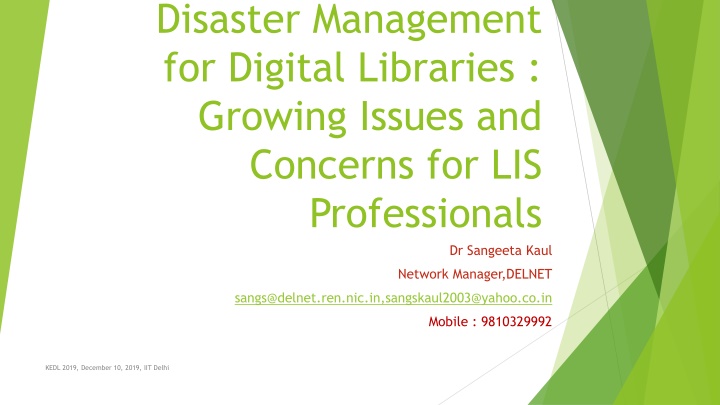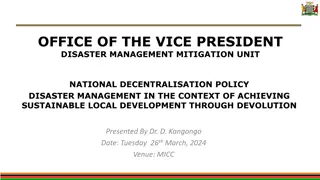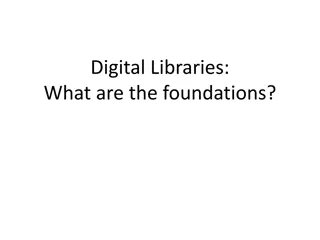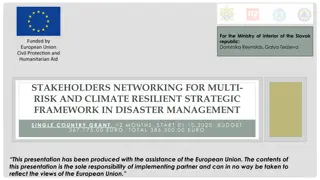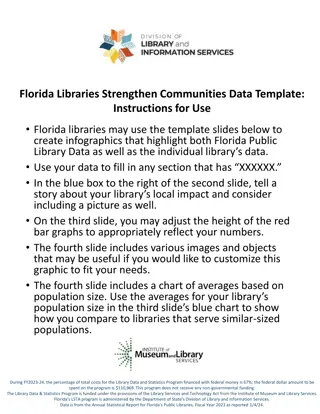Disaster Management for Digital Libraries: Critical Issues and Solutions
Disaster recovery planning and business continuity planning are essential for digital library systems to ensure operational resilience in the face of disasters. National bodies like CERT-In in India and systems like the USA National Incident Management System provide frameworks for disaster preparedness. The increasing need for cyber security professionals underscores the importance of safeguarding digital content and systems. Technical and natural threats pose risks to digital libraries that need to be effectively managed to ensure uninterrupted access to information.
Download Presentation

Please find below an Image/Link to download the presentation.
The content on the website is provided AS IS for your information and personal use only. It may not be sold, licensed, or shared on other websites without obtaining consent from the author.If you encounter any issues during the download, it is possible that the publisher has removed the file from their server.
You are allowed to download the files provided on this website for personal or commercial use, subject to the condition that they are used lawfully. All files are the property of their respective owners.
The content on the website is provided AS IS for your information and personal use only. It may not be sold, licensed, or shared on other websites without obtaining consent from the author.
E N D
Presentation Transcript
Disaster Management for Digital Libraries : Growing Issues and Concerns for LIS Professionals Dr Sangeeta Kaul Network Manager,DELNET sangs@delnet.ren.nic.in,sangskaul2003@yahoo.co.in Mobile : 9810329992 KEDL 2019, December 10, 2019, IIT Delhi
Introduction Disaster Recovery Planning (DRP) and Business Continuity Planning (BCP) are two of the most critical components of a Digital Library System Infrastructure. According to Gartner Research, two out of five organisations that suffers a disaster are out of operations within five years. KEDL 2019, December 10, 2019, IIT Delhi
National Bodies for Disaster Management India : CERT-In (Indian Computer Emergency Response Team), MEITY, Govt of India (www.cert-in.org.in) is operational since January 2004. It is the national nodal agency in India for responding to computer security incidents as and when they occur. The main areas of functions :Collection, Analysis and Dissemination of information on cyber incidents, forecast and alerts of cyber security incidents, emergency measures for handling cyber security incidents, issues guidelines, advisories, vulnerability notes and white papers relating to information security practices, etc. A toll free phone for reporting Cyber security incidence is made available by them at : +91-1800-11-4949, Tel: 011- 24368572 . KEDL 2019, December 10, 2019, IIT Delhi
USA National Incident Management System (NIMS) The NIMS mandates compliance with standards in various areas related to disaster preparedness developing emergency operation plans, training for staff members for emergency response systems and also institutionalizing incidence response command systems. KEDL 2019, December 10, 2019, IIT Delhi
According to NASSCOM,1 million cyber security professionals will be required in India by 2020. India ranks third in the number of cyber threats after United States and China and ranks fourth globally with 8 percent of global detections of ransomware ( a malicious software which locks computer and demands money to unlock it). The institutions are increasingly employing cyber security professionals who can build tools to safeguard their online systems and also the content. IIT Kanpur has recently started Advanced Certification Programme on Cyber Security and Cyber Defence. Cyber Peace Foundation, Ranchi is yet another organization which is working in this area for quite some time now. Disaster Resilient Cities are getting developed now. KEDL 2019, December 10, 2019, IIT Delhi
Threats Technical Threats : Computer Hardware Failure, Problem with Internet Access, Power Failure, data loss due to inadequate backup. Natural Threats: Floods, Earthquakes, etc Human Threats : Computer hacking threats, Human error while working on the systems, sabotage, etc KEDL 2019, December 10, 2019, IIT Delhi
Principles Guiding the Disaster Recovery Plan Disaster related damages should be limited Financial Losses and Legal Liabilities should be mitigated. The costs of Recovery Operations should be minimized. KEDL 2019, December 10, 2019, IIT Delhi
BIRA Business Impact and Risk Analysis BIRA helps in assessing the following : The most critical processes in an institution/ library Who is affected the most by not having services? How long can the library function without these processes ? How long will it take to restore in case of a disaster ? What are the existing vulnerabilities in the Digital Library developed ? How can the institution/library eradicate the risks involved ? The cost analysis for risk management. BIRA provides adequate guidelines for developing individual disaster recovery plans for each mission critical service in a library including the Digital Library. KEDL 2019, December 10, 2019, IIT Delhi
Guidelines for Institutions Building Digital Libraries To develop an overall Disaster Recovery strategy plans that takes into consideration the processes for recovery in case of a disaster. Every Institution must have their Digital Library Disaster Recovery Policy To create a DisasterTeam a manpower team from the existing staff which are responsible for creating exhaustive plans and procedures for recovery of the operations of the digital library. A Disaster Team Leader will have the prime responsibility of coordinating the work. There is a need to appoint a Disaster Recovery Coordinator for the Digital Libraries. To test the trial run to ascertain its functionality A regular review process should be undertaken to ensure that the recovery plan remains applicable. KEDL 2019, December 10, 2019, IIT Delhi
A mirroring site to be developed for each Digital Library application developed so that in case of a disaster the access can automatically be activated from the parallel mirroring site. Australian Library and Information Association noted that digital library software can be set to capture an image of a library s system every 15 minutes. This would ensure that the data is exposed for risk for not more than 15 minutes. KEDL 2019, December 10, 2019, IIT Delhi
The Disaster Response and Recovery Plans and Policies should be made available at the Institutional website. Some of the major Digital Libraries like Haathi Trust has laid down their policies for Disaster Management, but otherwise these policies for the Digital Libraries are not much transparent. KEDL 2019, December 10, 2019, IIT Delhi
There is a need to address and integrate the data security issues at the time of conceptualizing the Digital Libraries at the application level itself rather than installing the security patches later. There is a need for a regular training of the library manpower engaged in developing the Digital Libraries. The areas covered may include disaster management, current security threats, use of various software tools for enhancing the security and mitigating the vulnerabilities of the servers hosting the digital libraries, the use of cyber threat monitoring software, etc. The LIS professionals needs to work as Cyber Security specialists. KEDL 2019, December 10, 2019, IIT Delhi
Libraries should aim at implementing ISO 16363 :2012. It defines a recommended practice for assessing the trustworthiness of digital repositories. It is applicable to entire range of digital repositories. The efforts should be made to get ISO 16363 certification of Trustworthy Digital Repository for the Digital Libraries developed. KEDL 2019, December 10, 2019, IIT Delhi
Important Resource for Libraries for Disaster Management Disaster Recovery Journal www.drj.com KEDL 2019, December 10, 2019, IIT Delhi
Thank You ! KEDL 2019, December 10, 2019, IIT Delhi
